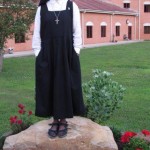It is fascinating to ponder the Taoist idea of Yin and Yang – the notion of an eternal cycle that grows to a fullness that must then transition to something else. I wrote about it once, in a manner of speaking, when thinking about the bliss of the Divine Office:
A beautiful depiction of the constant-renewal of the world and all Creation in it, including you and me. I prayed the psalms and considered the slow lifting of the darkness on this overcast autumn day, the first-turning leaves, from green-to-gold. Summertime had reached its absolute fullness, and–being wholly and fully summer, was incapable of being more of what it was–summer began to go . . .Of course, if we offer to be used, we had better mean it, because as we have seen time and again, when you make that offer, Christ will use you until you are completely and wholly used up, until you are nothing more than cinder. Until you can’t be summer anymore and must burst into splendid autumn.
An OSV piece by Mary DeTurris Poust put me in mind of that Yin and Yang — that eternal cycle of fullness and emptying, activity and quiessence — as regards our youth and our catechesis. Mary writes:
. . . it was with great interest that I read stories about a recent conference at Fordham University that was focusing on a “lost generation,” only the generation in question is the 20-something generation of today. The follow-up stories shared the good news that this generation isn’t really lost at all.
“Catholic young adults aren’t as attached to the church as their counterparts from the 1940s and 1950s, but they are hardly a lost generation and have not abandoned the faith, according to speakers at a two-day forum at Jesuit-run Fordham University.”
Notice who they’re looking at: Catholic young adults and their “counterparts” from the 1940s and 50s. What about their counterparts from the 1960s and 70s? Their parents? That is the original lost generation, my generation, the folks who were lost along the way as the Church changed the methods and content of catechesis.
Mary expounds on the need to reach out to that “lost” generation, and I’d certainly love to see a discussion among readers take root here in the comments section about what successes or failures some of your parish communities have seen.
But the issue strikes me, always, as being partly one of perspective, and of that Yin/Yang cycle.
I find that as a rule when comparisons are done — particularly as regards vocations, but also on participation — researchers love to start by citing figures from the Catholic “heydey” of the 50’s, when the church in just about all areas was at her Zenith; there were more priests and nuns, more flourishing communities and parishes, more schools in operation, more missions, more “everything” than at any time previous in the church’s history.
But those numbers are always an aberration, particularly as to vocations:
. . . and well up to the first World War, priests and nuns were distinct, small minorities. Convents, abbeys, friaries grew then scattered, and their growth was always greater where people were poorer, and thus less distracted by the lure of materialism – more open to the small, still voice calling their names.
And too, vocations used to bring with them a bit of social cache. If you were a priest or sister, you may never be a king or queen, but you were likely to get some education, a sense of community and your meals, however frugal. Many a sound and fervent vocation began with an empty belly and a thirst for learning, and there is nothing wrong with that. The Holy Spirit has ways of using everything to God’s own purpose.
Comparing vocations and participation within the modern church to those “heyday” numbers will always paint a dreary picture. If anyone would compare today’s numbers to oh, say, 1978-1989, I believe the picture would become much brighter.
A less-than-stellar understanding and implementation of the documents and reforms of the Second Vatican Council undoubtedly had much to do with the drop in vocations and the mushing up/dumbing down of our catechesis. Transitions always blur, for a while. But I doubt it’s any accident that the dramatic turnaround in the church’s material and spiritual fortunes coincided with the beginning of a great period of secular material prosperity. The expansion of the middle class, the wealth of man-made opportunity, the distraction and deification of the popular culture all contributed to to the emptying of our pews and our catechetical content.
One might say the 60’s through the 80’s were the first yangthrust of cultural relativism. The philosophy so succinctly expressed in the lyrics, “It’s you’re thing, do what you want to do/I can’t tell you who to sock it to,” had a profound influence on Catholic laity, just at the moment they were permitted to enter into liturgical and catechetical planning, and the age began to influence the church, rather than the church influencing the age.
Think again of the Yang that becomes so full of itself that it can be no more and must revert to Yin – it’s the same sort of thing. The boisterous Church of the 50’s and late 40’s bore no relation to the previous 1900 years of the church as it built toward than end. The Church became so full of itself (in many ways – and perhaps that contributed to the terrible abuses of that era, for which we are paying, now) that it could be no more of what it was; the 60’s through ’80s were the beginning of the Yin – that transitional time that lies fallow a while and then grows in quiescence until it can be no more. No one pays attention to that first, transitional blip — that move from white to black or black to white — and many end up falling through the cracks, it’s sad but true; a truth that repeats in history.
There is always that “slipped” generation that gets missed and shortchanged when yang moves to yin and yin to yang. I figure God must have a particular abundance of mercy for those lost in the blur, because the transition leaves them so vulnerable and untethered. If that is true, then he will surely give us the means to reclaim his lost sheep. I believe, in fact, that in our two most recent popes — and even the advent of alternative media — he has done just that.
Related:
More on that Fordham Conference












